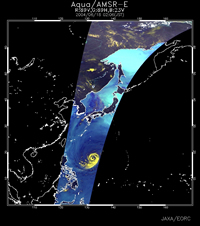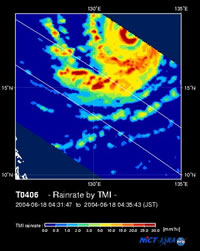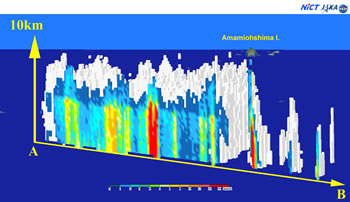Seen from Space 2004
Powerful and Major Typhoon DIANMU Approaching
Typhoon DIANMU (NO.6 in 2004) was acquired by AMSR-E, developed by JAXA and flown aboard Aqua, and by TMI flown aboard the Tropical Rainfall Measuring Mission (TRMM). Figure 1 is an AMSR-E near-real-time image. Dark blue on the sea surface indicates a large volume of water vapor in the atmosphere, and yellow, well-developed clouds. These images can be seen in " Today's Image " on EORC's webpage.
Figure 2 indicates the precipitation as acquired by TMI. In the orange area, the rain is heavy enough to bounce from the ground onto your feet while walking, and in the red area, the rain is so heavy that an umbrella would not prevent you from getting wet. You can see the strong precipitation area in red around the clear eye.
Figure 2 depicts the three-dimensional rainfall structure and the cross- section acquired by PR observation. The top of the rainfall is 8 km high and you can find intense rainfall even in the area far from the eye of typhoon. Related sites:
|
|||||||||||||||||||||||||||||||||||||||







